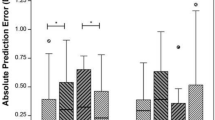Abstract
In analyses of bivariate ordered polytomous cataract data from atomic-bomb survivors, we compared two methods, the univariate worse-eye method, and the bivariate generalized estimating equations (GEE’s) method using global odds ratio by Williamson et al. (Journal of the American Statistical Association, 90, 1432–1437, 1995). When the association was large and only subject level covariates were used, model selection in the univariate and bivariate methods resulted in the same mean model and similar risk estimates. We showed that the mean parameter and the standard error (SE) in the univariate model are emphasized relative to those in the bivariate model, the biases of which are negligible when the association between both eyes is large. Large sample simulation studies indicated that the univariate Wald statistics are slightly conservative. The simulations also showed that, in bivariate cases, irrespective of the degree of association, the independence estimating equations method with robust SE, and the GEE method with model-based and robust SE are almost fully efficient in parameter estimation when only subject level covariates are included in the mean.
Similar content being viewed by others
References
Akaike H. (1973). Information theory and an extension of maximum likelihood principle. In: Petrov B.N., Czaki F. (eds) 2nd International Symposium on Information Theory. Budapest, Akademiai Kiado, pp. 267–281
Choshi K., Takaku H., Mishima T., Takase S., Neriishi S., Finch C., Otake M. (1983). Ophthalmologic change related to radiation exposure and age in Adult Health Study sample, Hiroshima and Nagasaki. Radiation Research, 96, 560–579
Chylack L.T., Leske C., MacCarthy D., Khu P., Kashiwagi T., Sperduto R. (1989). Lens opacity classification system II (LOCS II). Archives of Ophthalmology 107, 991–997
Chylack L.T., Wolfe J.K., Singer D.M., Leske M.C., Bullimore M.A., Bailey I.L., Friend J., MaCarthy D., Wu S.Y. (1993). The lens opacities classification system III, The longitudinal study of cataract study group. Archives of Ophthalmology 111, 831–836
Dale J.R. (1984). Local versus global association for bivariate ordered responses. Biometrika 71, 507–514
Dale J.R. (1986). Global cross-ratio models for bivariate, discrete ordered responses. Biometrics 42, 909–917
Diggle P.J., Heagerty P., Liang K.-Y., Zeger S.L. (2002). Analysis of longitudinal data (2 Ed.) Oxford University Press, Oxford
Ekholm A., Jokinen J., McDonald J.W., Smith P.W.F. (2003). Joint regression and association modeling of longitudinal ordinal data. Biometrics 59, 795–803
Ekholm A., Smith P.W.F., McDonald J.W. (1995). Marginal regression analysis of a multivariate binary response. Biometrika 82, 847–854
Gange S.J., Linton K.L.P., Scott A.J., DeMets D.L., Klein R. (1995). A comparison of methods for correlated ordinal measures with ophthalmic applications. Statistics in Medicine 14, 1961–1974
Gunsolley J.C., Getchell C., Chinchilli V.M. (1995). Small sample characteristic of generalized estimating equations. Communication in Statistics Simulation and Computation 24, 869–878
Kim K. (1995). A bivariate cumulative probit regression model for ordered categorical data. Statistics in Medicine 14, 1341–1352
Lee Y., Nelder J.A. (2004). Conditional and marginal models: another view. Statistical Science 19, 219–238
Liang K.-Y., Zeger S.L. (1986). Longitudinal data analysis using generalized linear models. Biometrika 73, 13–22
Liang K.-Y., Zeger S.L., Qaquish B. (1992). Multivariate regression analyses for categorical data (with discussion). Journal of the Royal Statistical Society Series B 54, 3–40
Lipsitz S.R., Laird N.M., Harrington D.P. (1991). Generalized estimating equations for correlated binary data: using the odds ratio as a measure of association. Biometrika 78, 153–160
Lumley T. (1996). Generalized estimating equation for ordinal data: A note on working correlation structure. Biometrics 52, 354–361
McCullagh P., Nelder J.A. (1989). Generalized linear models. London, Chapman and Hall
Miller M.E., Davis C.S., Landis J.R. (1993). The analysis of longitudinal ordered polytomous data: Generalized estimating equations and connection with weighted least squares. Biometrics 49, 1033–1044
Minamoto A., Taniguchi H., Yoshitani N., Mukai S., Yokoyamoa T., Kumagami T., Tsuda Y., Mishima H., Amemiya T., Neriishi K., Nakashima E., Hida A., Fujiwara S., Suzuki G., Akahoshi M. (2004). Cataract study in atomic-bomb survivors. International Journal of Radiation Biology 80, 339–345
Molenberghs G., Lesaffre E. (1994). Marginal modeling of correlated ordinal data using a multivariate Plackett distribution. Journal of the American Statistical Association 89, 633–644
Nakashima E., Neriishi K., Minamoto A. (2006). A reanalysis of atomic-bomb cataract data, 2000–2002: A threshold analysis. Health Physics 90, 154–160
O’Hara Hines R.J. (1997). Analysis of clustered polytomous data using generalized estimating equations and working correlation structures. Biometrics 53, 1552–1556
Pan W. (2001). Akaike’s information criterion in generalized estimating equations. Biometrics 57, 120–125
Plackett R.L. (1965). A class of bivariate distribution. Journal of the American Statistical Association 60, 516–522
Sharples K., Breslow N. (1992). Regression analysis of correlated binary data: some small sample results for the estimating equation approach. Journal of Statistical Computation and Simulation 42, 1–20
Williamson J.M., Kim K.-M., Lipsitz S.R. (1995). Analyzing bivariate ordinal data using a global odds ratio. Journal of the American Statistical Association 90, 1432–1437
Yokoro K. (eds.) (1991). A review of forty-five years of study of Hiroshima and Nagasaki atomic-bomb survivors. Summary and conclusion. Journal of Radiation Research (Tokyo), 32 (suppl.).
Young R., Bennett B. (eds.) (2006). DS02: A revised system for atomic bomb survivors dose estimation, Radiation Effects Research Foundation, Hiroshima.
Author information
Authors and Affiliations
Corresponding author
About this article
Cite this article
Nakashima, E., Neriishi, K. & Minamoto, A. Comparison of methods for ordinal lens opacity data from atomic-bomb survivors: univariate worse-eye method and bivariate GEE method using global odds ratio. Ann Inst Stat Math 60, 465–482 (2008). https://doi.org/10.1007/s10463-007-0113-9
Received:
Revised:
Published:
Issue Date:
DOI: https://doi.org/10.1007/s10463-007-0113-9




